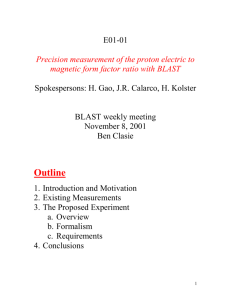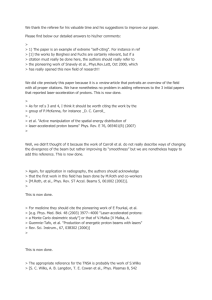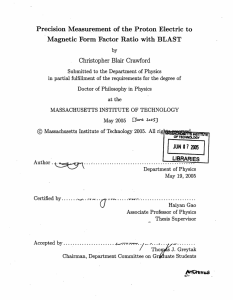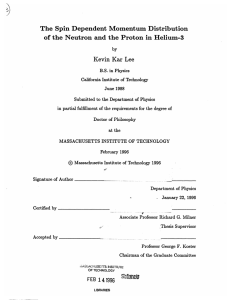Word - MIT
advertisement
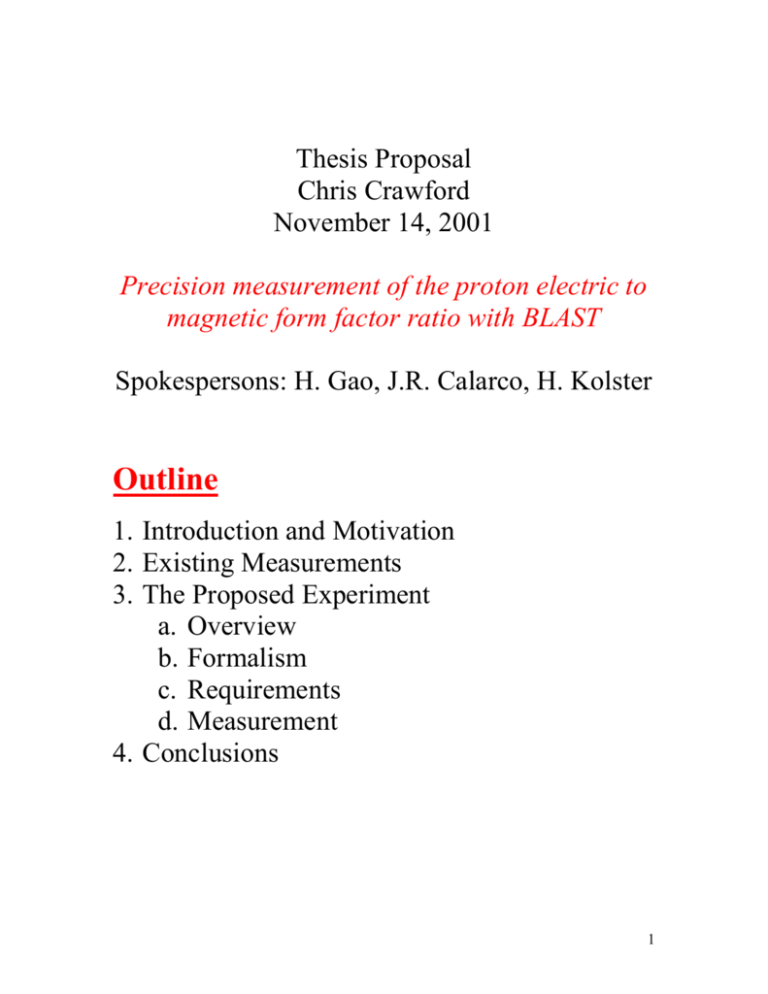
Thesis Proposal Chris Crawford November 14, 2001 Precision measurement of the proton electric to magnetic form factor ratio with BLAST Spokespersons: H. Gao, J.R. Calarco, H. Kolster Outline 1. Introduction and Motivation 2. Existing Measurements 3. The Proposed Experiment a. Overview b. Formalism c. Requirements d. Measurement 4. Conclusions 1 1. Introduction and Motivation The electromagnetic form factors are fundamental quantities related to the distribution of charge and magnetization within a nucleon. The electromagnetic form factor ratio is also important, as any Q2 dependence will suggest different charge and magnetization spatial distributions inside the nucleon. o High Q2 (beginning at 0.5 GeV2 ) results from JLAB show a downward trend in this ratio for the proton. o More recent higher Q2 data from JLAB show a continuing downward trend up to Q2 =5.6 GeV2. o Low Q2 data from 0 – 1 GeV2 is the focus of this experiment, which is required to determine the turning point in the Q2 dependence of the ratio. 2 Theory Lattice calculations: o expected in the near future for low Q2 (0 – 1 GeV2). Models with explicit meson degrees of freedom: o Vector Meson Dominance (VMD), Höhler 1976. Photons couple to hadrons only via intermediate vector bosons. o VMD and Chiral Perturbation Theory (ChPT), Mergell et al. 1996. o Soliton Model, Holzworth 1996. This treats the Baryon as an extended object with coupling to vector mesons. QCD based Quark models: o Constituent quarks, Frank et al. 1996. This model constructs valence quark wavefunctions and does not include the pion cloud or gluons. o Cloudy bag, Lu et al. 1998. Photons couple with a valence quark core and meson fields. 3 4 2. Measurement Techniques Rosenbluth separation unpol P2 P2 G E GM d 1 2 e P2 Mott f recoil 2 GM tan 2 1 d 2 2 o Plot of d d vs. tan2(/2) gives GMP and GEP o Difficult at Q 2 1 GeV 2 ( GEP ), and low Q 2 ( G MP ). Polarization transfer measurements p (e , ep ) using a Focal Plane Polarimeter (FPP). Pt E E e GEP tan P GM Pl 2M P 2 Pt and Pl of the scattered proton were measured simultaneously within the FPP using scattering from 12 C . o Milbrath et al. (BATES), 1999. Also d (e , ep)n o Jones et al. (JLAB), 2000. o Dieterich et al. (MAMI, Mainz), 2001. Polarized beam and target measurement o Well suited to BLAST o Different systematics than above o Insensitive to beam and target polariazation o Our proposed experiment 5 Unpolarized Scattering and Polarization Transfer Data Polarization Transfer Data 6 3. The Proposed Experiment 3a. Overview Will use the reaction p(e , ep) to measure p GEP GMP at Q2 = 0.07 – 0.9 GeV 2 to unprecedented precision at beam energies 440 MeV and 880 MeV. Completely different experimental technique: polarized H target instead of recoil proton polarimeter. Fits nicely between higher Q2 data at JLAB and lower Q2 data from RPEX (future exp at BATES) p GEP GMP from Q2 = 0.02 – 6 (GeV/c) 2. Approved at the 28th BATES PAC with the highest scientific priority. 7 3b. Formalism A longitudinally polarized electron scatters from a polarized proton in the lab frame. The proton may be polarized in any direction described * * by θ and φ with respect to q . The cross section for polarized scattering d h d where h is the helicity of the electron beam, is the unpolarized cross section and is the spin dependent part. 8 Theoretical asymmetry: 2 vT cos * G MP 2 2 (1 )vTL sin * cos *G MP G EP A 2 2 (1 )v L G P 2 vT G P 2 E M Experimental asymmetry: Aexp N N Pb Pt A N N Ratio of AL and AR (same Q 2 ): Rexp AL 2 vT cos L* 2 2 (1 )vTL sin L* cos L* GEP GMP AR 2 vT cos R* 2 2 (1 )vTL sin R* cos R* GEP GMP We are therefore able to extract the form factor ratio independent of the beam and target polarizations to first order. 9 3c. Requirements Polarized electron beam stored in the ring (SHR) o 60% polarization, 80μA average current o Compton polarimeter Polarized internal hydrogen target o Atomic Beam Source (ABS) o Laser Driven Target (LDT) Symmetric Large Acceptance Detector (BLAST). o Toroidal Magnetic Field o Wire Chambers o Timing Scintilators o Cěrenkov o Lead Glass Calorimeter o Neutron Detectors 10 Polarized Beam Asymmetry The Compton Polarimeter 0.01 0.008 0.006 0.004 0.002 -0 -0.002 -0.004 -0.006 -0.008 -0.01 2468 10 12 14 Gamma Energy (MeV) 11 Polarized Target Atomic Beam Source o Well established technology o Can create pure spin states o Polarization: o Flux: o Thickness: P = 0.8 = 7×1016 /s t = 5.5×1013 /cm2 Laser Driven Target o Compact design o Active pumping—higher flux o Flux: = 2×1018 atoms/s o Atomic fraction F = 0.6 (expected) o Polarization P = 0.5 (expected) 12 Atomic Beam Source 13 Atomic Beam Source 14 Laser Driven Target Optical Pumping and Spin Exchange rf OPTICAL PUMPING K K H2 H K H KH SPIN EXCHANGE OPTICAL PUMPING K H K H H K K H HH SPIN EXCHANGE H H H Schematic of Target RF dissociator H2 potassium ampoule spincell magnetic holding field circularly polarized laser storage cell 15 16 Dissociation Results: Atomic fraction at the target cell using the new dissociator. 95 Atomic Fraction (%) 90 85 80 75 70 65 Spincell heating up 60 Potassium heating up, spincell at 180C 55 20 40 60 80 100 120 140 160 180 Temp (C) Polarization Results: Negative Helicity Positive Helicity 10 10 Laser transmission 9 9 8 8 7 7 6 6 5 5 4 4 3 Laser transmission 3 QMA mass 1 signal 2 2 1 1 QMA mass 1 signal 0 0 770.105 Laser wavelength (nm) 770.115 770.105 Laser wavelength (nm) 770.115 17 BLAST Detector 18 Monte Carlo Momentum Reconstruction h1 Theta Reconstruction h3 Nent = 3990 Mean = -0.03706 RMS = 0.9919 240 220 Nent = 4142 Mean = 0.02022 RMS = 0.639 600 200 180 500 160 400 140 120 300 100 80 200 60 40 100 20 0 -5 -4 -3 -2 -1 012345 % error inp 0 -5 -4 -3 -2 -1 012345 % error in q 19 3d. Measurement E(MeV) 440(c) 880(c) 880(s) 880(c)* e min(deg) e max(deg) p min(deg) p max(deg) 33.5 26.5 82.5 82.5 103.0 113.0 37.8 30.5 18.9 18.9 66.2 65.5 30.5 22.3 (c) coincidence (s) proton singles * (c) coincidence with extra detectors Beam time: 300 hrs (440 MeV), 900 hrs (880 MeV) Luminosity: L = 2.7×1031 s-1 cm-2 E = 440 MeV <Q > rate (MeV2) (Hz) 0.07 33.5 0.10 8.5 0.13 4.4 0.16 2.4 0.20 1.4 0.23 0.9 2 dR/R (%) 0.46 0.69 1.47 1.?? 1.70 1.72 E = 880 MeV <Q > Rate (MeV2) (Hz) 0.21 6.41 0.34 1.67 0.47 0.56 0.59 0.23 0.69 0.11 0.85 0.08 2 dR/R (%) 0.40 0.35 0.44 0.66 1.17 2.49 Systematic Errors o scattered electron energy o scattered electron angle o target spin direction 20 21 4. Conclusions This experiment will be the first determination of the proton form factor ratio using the p(e , ep) reaction. The proton form factor ratio will be measured from Q2 = 0.07 to 0.9 (GeV/c) 2 to unprecedented precision and dominated by statistical error. This experiment is well suited for BLAST. In the future a 1.1GeV beam may be used with the same technique with BLAST to determine the proton form factor ratio to Q2 = 1.2 (GeV/c) 2. Acknowledgements B. Clasie, J. Seely, H. Kolster, V. Ziskin, M. Farkhondeh, B. Franklin, T. Smith 22 References Proposal to the MIT-Bates PAC “Precision measurement of the proton electric to magnetic form factor ratio with BLAST”. M. Jones et al., Phys. Rev. Lett. 84, 1398 (2000). B. Milbrath et al., Phys. Rev. Lett. 80, 452 (1998), Phys. Rev. Lett. 82, 221 (E) (1999). S. Dieterich et al., Phys. Lett. B500, 47 (2001). T. W. Donnelly et al., Ann. Phys. 169, 247 (1986). G. Höhler et al., Nucl. Phys. B114, 505 (1976). P. Mergell et al., Nucl. Phys. A596, 367 (1996). G. Holzworth, Z. Phys. A356, 339 (1996). M. R. Frank et al., Phys. Rev. C54, 920 (1996). D. H. Lu et al., Phys. Rev. C57, 2628 (1998). 23
